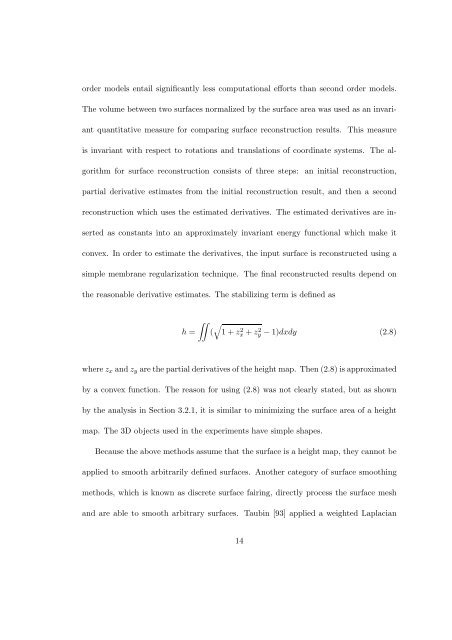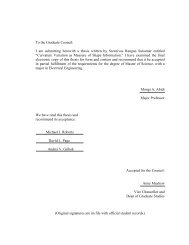- Page 1 and 2: To the Graduate Council:I am submit
- Page 3 and 4: Copyright c○ Yiyong Sun, 2002All
- Page 5 and 6: AcknowledgmentsFirst and foremost,
- Page 7 and 8: search employs an implicit surface-
- Page 9 and 10: 3.2.2 Edge Preservation for Range D
- Page 11 and 12: 8.2 Future Research . . . .........
- Page 13 and 14: List of Figures1.1 A framework for
- Page 15 and 16: 7.14 Finding corresponding points o
- Page 17 and 18: Chapter 1IntroductionThis introduct
- Page 19 and 20: Range ImageSmoothingRegistrationCol
- Page 21 and 22: obust to surface noise and registra
- Page 23 and 24: more efficient than 2D image correl
- Page 25 and 26: scending path, and region merging.L
- Page 27 and 28: two-dimensional (2D) image, 2D lowp
- Page 29: curvatures of points on a surface i
- Page 33 and 34: with different surface representati
- Page 35 and 36: center point and every surface poin
- Page 37 and 38: Table 2.1: Comparison of different
- Page 39 and 40: Reconstruction from Unorganized Poi
- Page 41 and 42: tional. An offset of the distance f
- Page 43 and 44: surement confidence. However, in or
- Page 45 and 46: triangle mesh. The triangle mesh is
- Page 47 and 48: mesh segmentation based on the phys
- Page 49 and 50: Rettmann et al. [70] proposed a mes
- Page 51 and 52: successful smoothing for both raw r
- Page 53 and 54: where lim t→0 (R/t) =0,H represen
- Page 55 and 56: the range r ij is estimated instead
- Page 57 and 58: y minimizing the following energy f
- Page 59 and 60: tions were used:r α = r i,j+1 −
- Page 61 and 62: where κ represents a parameter tha
- Page 63 and 64: inequality, such asI∑I∑S i ≤
- Page 65 and 66: n ′ in iT ipqn ipw in ′ i−→
- Page 67: The singular value decomposition is
- Page 70 and 71: a limit on sharp edges. This limit
- Page 72 and 73: of the smoothing.Surface smoothing
- Page 74 and 75: fingerprint are presented. Section
- Page 76 and 77: erroneously includes surface patch
- Page 78 and 79: (ρ, θ)ρθT p (S)expSexp p (ρ,
- Page 80 and 81:
exponential map is introduced.4.2 F
- Page 82 and 83:
accurately than Dijkstra’s algori
- Page 84 and 85:
andθ = arccos ρ2 (A)+|AB| 2 −
- Page 86 and 87:
andy =((n × −→ pm) × n) · v
- Page 88 and 89:
images.4.3 Candidate Point Selectio
- Page 90 and 91:
(a)(b)(c)(d)Figure 4.6: Global fing
- Page 92 and 93:
and R ij is below a threshold. The
- Page 94 and 95:
If the singular-value decomposition
- Page 96 and 97:
Chapter 5Surface Reconstruction fro
- Page 98 and 99:
Figure 5.2: Two registered and over
- Page 100 and 101:
Figure 5.4: Intersecting triangles.
- Page 102 and 103:
Figure 5.7: Gap between surfaces af
- Page 104 and 105:
5.2 Volume-Based Surface Integratio
- Page 106 and 107:
2D texture coordinate of x is set t
- Page 108 and 109:
ABFigure 5.9: Hole filling illustra
- Page 110 and 111:
are presented in Section 7.4.6.1 A
- Page 112 and 113:
6.3 Applying the Fast Marching Wate
- Page 114 and 115:
Algorithm 6.2 (Fast Marching Waters
- Page 116 and 117:
15: end if16: if v i.h
- Page 118 and 119:
6.3.2 Geodesic ErosionThis step ass
- Page 120 and 121:
(a)(b)(c)(d)Figure 6.3: Segmenting
- Page 122 and 123:
Chapter 7Experimental ResultsThis c
- Page 124 and 125:
no discernible improvement. For fai
- Page 126 and 127:
(a)(b)(c)(d)Figure 7.4: Surface smo
- Page 128 and 129:
(a)(b)(c)(d)Figure 7.6: Smoothing s
- Page 130 and 131:
(a)(b)(c)(d)(e)(f)Figure 7.8: Adapt
- Page 132 and 133:
The real range images were scanned
- Page 134 and 135:
(a)(b)Figure 7.10: Registration of
- Page 136 and 137:
(a)(b)(c)(d)(e)(f)Figure 7.12: Matc
- Page 138 and 139:
(a) (b) (c) (d)(e) (f) (g) (h)(i)(j
- Page 140 and 141:
(a)(b)ICP Registration Error (mm)21
- Page 142 and 143:
(a)(b)(c)(d)(e)(f)Figure 7.17: Surf
- Page 144 and 145:
Table 7.1: Small parts 3D reconstru
- Page 146 and 147:
(a)(b)(c)(d)Figure 7.21: Surface mo
- Page 148 and 149:
(a)(b)Figure 7.23: Automatic hole f
- Page 150 and 151:
(a)(b)(c)(d)(e)(f)(g)(h)Figure 7.25
- Page 152 and 153:
(a)(b)(c)(d)Figure 7.27: Four-view
- Page 154 and 155:
(a)(b)(c)(d)Figure 7.28: Segmentati
- Page 156 and 157:
(a)(b)(c)(d)Figure 7.30: Surface se
- Page 158 and 159:
Table 7.2: Performance of the fast
- Page 160 and 161:
surface reconstructed from the raw
- Page 162 and 163:
to choose a proper flowing step siz
- Page 164 and 165:
of interest based on the shape irre
- Page 166 and 167:
8.2 Future ResearchThere are many o
- Page 168 and 169:
Bibliography[1] E. L. Allgower and
- Page 170 and 171:
[26] G. Dziuk and J. E. Hutchinson.
- Page 172 and 173:
[54] W. E. Lorensen and H. E. Cline
- Page 174 and 175:
[81] M. Soucy and D. Laurendeau. A
- Page 176 and 177:
[106] S. M. Yamany, A. A. Farag, an
- Page 178 and 179:
Appendix ALaser Range ScannersLaser
- Page 180 and 181:
(a)(b)Transmitter LensTargetDiodeLa
- Page 182 and 183:
A.2 Scanners Based on Laser Triangu
- Page 184 and 185:
LaserBaseline B-s0saOpticalCenter(a
- Page 186 and 187:
Appendix BSimplification of theArea
- Page 188:
VitaYiyong Sun was born in Beijing,
















